
Usage-based pricing has become increasingly popular among SaaS providers and cloud platforms, offering organizations the flexibility to pay only for what they consume. While this model promises cost efficiency and scalability, it also introduces significant challenges that can lead to unexpected billing surprises and budget volatility. Understanding these pitfalls and implementing effective management strategies is crucial for organizations seeking cost-effective app management and automated SaaS tracking.
Understanding Usage-Based Pricing Models
Usage-based pricing, also known as consumption-based pricing or pay-as-you-go pricing, charges customers based on their actual consumption of a service rather than a fixed subscription fee. This model has gained traction across various technology sectors, from cloud computing resources to SaaS applications, offering both advantages and potential risks.
Unlike traditional subscription models where costs remain predictable, usage-based pricing creates a direct correlation between consumption and costs. Organizations implementing business software savings strategies must carefully navigate this model to avoid common pitfalls that can lead to budget overruns and financial surprises.
The appeal of usage-based pricing lies in its promise of cost optimization—organizations theoretically pay only for what they use, eliminating waste associated with over-provisioned resources. However, this model requires sophisticated automated app tracking and monitoring capabilities to prevent unexpected charges and maintain financial control.
Common Pitfalls in Usage-Based Pricing
Unpredictable Cost Spikes
One of the most significant challenges with usage-based pricing is the potential for sudden, unexpected cost increases. Unlike fixed subscription models where monthly costs remain constant, usage-based pricing can result in dramatic billing variations based on consumption patterns.
These spikes often occur due to seasonal business fluctuations, marketing campaigns that drive increased traffic, or system inefficiencies that consume more resources than anticipated. Organizations without proper centralized app management systems may find themselves blindsided by bills that exceed their budgets by significant margins.
For example, a company running a marketing campaign might experience a 300% increase in web traffic, leading to proportional increases in cloud computing costs, API calls, and data processing charges. Without proper monitoring and alerting systems, these costs can accumulate quickly, resulting in budget overruns that strain organizational finances.
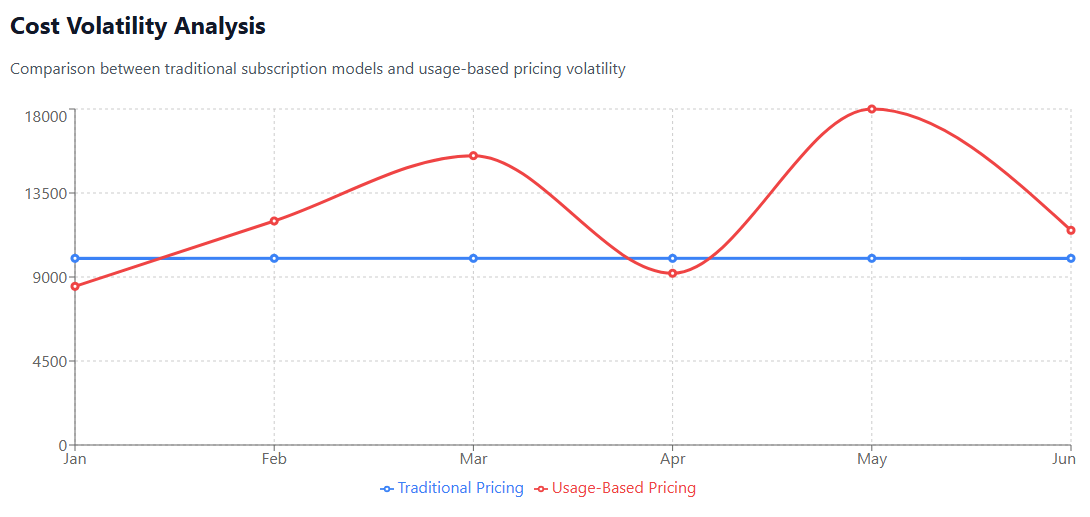
Lack of Visibility and Tracking
Many organizations struggle with insufficient visibility into their usage patterns and associated costs. Traditional accounting systems are often inadequate for tracking granular, consumption-based charges across multiple services and departments. This lack of transparency makes it difficult to identify cost drivers, optimize usage, and implement effective control app expenses strategies.
The complexity increases when organizations use multiple vendors with different usage-based pricing models. Each provider may have unique metrics, billing cycles, and reporting formats, making it challenging to consolidate and analyze spending across the entire technology stack. Without comprehensive visibility, organizations cannot effectively manage their app budget management initiatives.
Moreover, many teams within organizations may be unaware of how their activities translate into costs under usage-based models. Development teams might run extensive testing without understanding the financial implications, or marketing teams might launch campaigns without considering the downstream infrastructure costs.
Difficulty in Budget Planning and Forecasting
Traditional budgeting processes become significantly more complex with usage-based pricing models. Financial teams accustomed to predictable monthly software subscriptions must now forecast variable costs based on projected usage patterns, business growth, and seasonal fluctuations.
This challenge is compounded by the fact that usage patterns may not follow linear growth trajectories. A successful product launch, viral marketing campaign, or system integration might create usage spikes that are difficult to predict using historical data. Organizations implementing budget management for startups face particular challenges, as they often lack extensive historical data for accurate forecasting.
The inability to accurately forecast costs can lead to several problems: inadequate budget allocation, cash flow issues, difficulty in securing funding or investment, and challenges in pricing products or services accurately. Organizations must develop sophisticated forecasting models that consider multiple variables and scenarios to maintain financial stability.
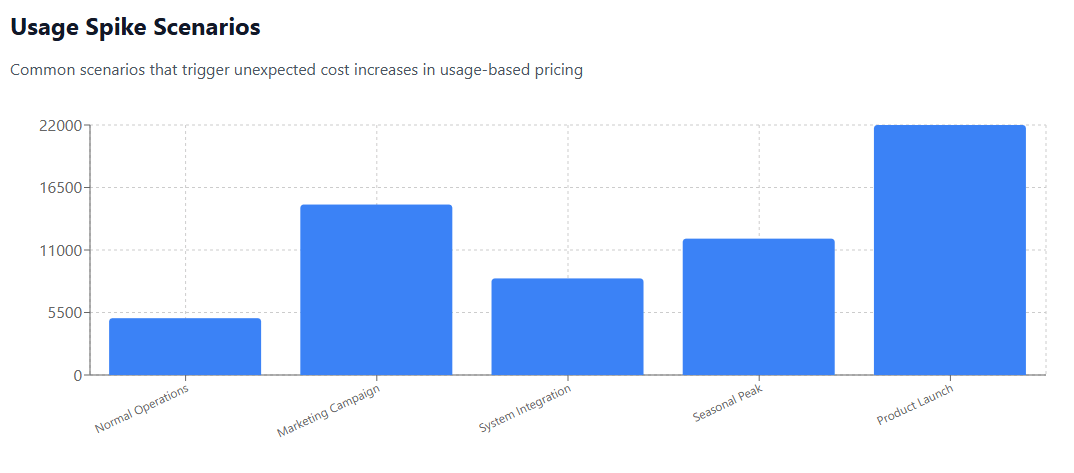
Hidden Costs and Complexity
Usage-based pricing models often include hidden costs that aren’t immediately apparent during the initial evaluation process. These may include data transfer charges, API rate limiting fees, premium support costs, or charges for exceeding certain thresholds or quotas.
The complexity of usage-based pricing structures can also lead to misunderstandings about what triggers charges and how costs accumulate. Organizations may discover additional fees for features they assumed were included, or find that their usage patterns result in higher per-unit costs than anticipated.
For instance, cloud providers might offer attractive base rates but charge significantly more for data egress, cross-region transfers, or peak-time usage. SaaS applications might have usage-based components for advanced features, integrations, or data storage that weren’t clearly communicated during the sales process.
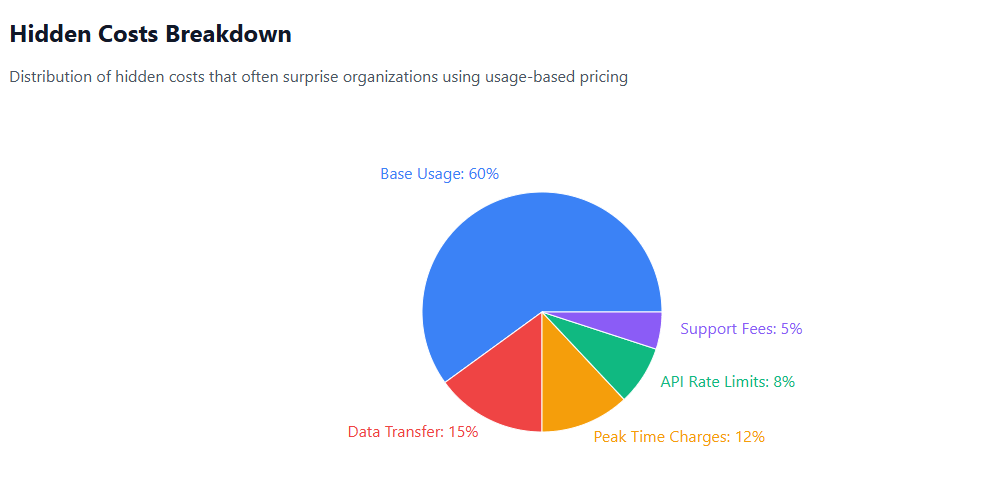
Impact on Business Operations
Financial Volatility and Cash Flow Issues
Usage-based pricing introduces financial volatility that can significantly impact business operations. Organizations may experience month-to-month cost variations of 50% or more, creating challenges for cash flow management and financial planning.
This volatility is particularly problematic for organizations with tight cash flow or those operating on investor funding with specific burn rate targets. Unexpected cost spikes can force difficult decisions about resource allocation, potentially impacting product development, marketing initiatives, or hiring plans.
The unpredictability also affects pricing strategies for organizations that resell services or products dependent on usage-based infrastructure. Companies must build in significant margins to account for potential cost spikes, which may make their offerings less competitive in the market.
Resource Allocation Challenges
Usage-based pricing can create perverse incentives within organizations, leading to suboptimal resource allocation decisions. Teams may under-utilize valuable services to avoid costs, missing opportunities for innovation or efficiency improvements. Conversely, lack of cost awareness might lead to wasteful over-consumption.
The challenge is particularly acute in environments where the users of services aren’t directly responsible for the associated costs. Development teams might choose less efficient solutions to avoid complex optimization work, not realizing the long-term financial implications of their decisions.
Organizations need to implement affordable SaaS solutions strategies that balance cost control with operational efficiency, ensuring that cost considerations don’t prevent teams from using the tools and resources they need to be productive.
Vendor Lock-in and Negotiation Difficulties
Usage-based pricing models can create subtle forms of vendor lock-in that become apparent only after organizations have significantly scaled their usage. Migration costs, both in terms of time and money, can become prohibitively expensive once systems are deeply integrated with usage-based services.
Additionally, negotiating better rates becomes more complex with usage-based models. Traditional software negotiations often focus on seat counts or feature sets, but usage-based negotiations require detailed analysis of consumption patterns, growth projections, and cost optimization opportunities.
Organizations may find themselves in weak negotiating positions if they’ve become heavily dependent on specific usage-based services without maintaining visibility into alternative options or maintaining budget-friendly SaaS solutions strategies.
Strategies for Managing Usage-Based Pricing
Implementing Comprehensive Monitoring and Alerting
Effective management of usage-based pricing requires robust monitoring and alerting systems that provide real-time visibility into consumption and costs. Organizations should implement automated tracking systems that monitor usage across all services and provide alerts when consumption approaches predefined thresholds.
These systems should integrate with existing financial and operational dashboards, providing stakeholders with the information they need to make informed decisions about resource utilization. Key metrics to monitor include daily and weekly consumption trends, cost per unit of business value, and variance from budgeted amounts.
Modern automated SaaS tracking tools can help organizations maintain visibility across their entire technology stack, providing consolidated reporting and alerting capabilities that simplify usage-based cost management. These tools should offer customizable alerting thresholds, detailed consumption analytics, and integration capabilities with existing business intelligence systems.
Establishing Clear Governance and Accountability
Organizations must establish clear governance frameworks that define roles and responsibilities for managing usage-based costs. This includes identifying who has authority to provision new services, who monitors consumption, and who is accountable for budget adherence.
Effective governance frameworks include approval processes for new usage-based services, regular review cycles for existing consumption patterns, and clear escalation procedures when costs exceed predefined thresholds. Organizations should also implement chargeback or showback mechanisms that help business units understand the cost implications of their usage patterns.
Training and education are crucial components of effective governance. Technical teams need to understand how their decisions impact costs, while financial teams need to understand the technical factors that drive consumption. This shared understanding enables better collaboration and more effective cost management.
Implementing Cost Optimization Tools and Practices
Organizations should invest in specialized tools and practices designed to optimize usage-based costs. This includes rightsize recommendations for cloud resources, automated scaling policies that adjust consumption based on demand, and optimization algorithms that select the most cost-effective service options.
Cost-effective app management strategies should include regular reviews of usage patterns to identify optimization opportunities. This might involve consolidating services, negotiating volume discounts, or implementing more efficient architectures that reduce overall consumption.
Organizations should also consider implementing reserved capacity or committed use agreements where appropriate. While these arrangements reduce flexibility, they can provide significant cost savings for predictable portions of their usage patterns.
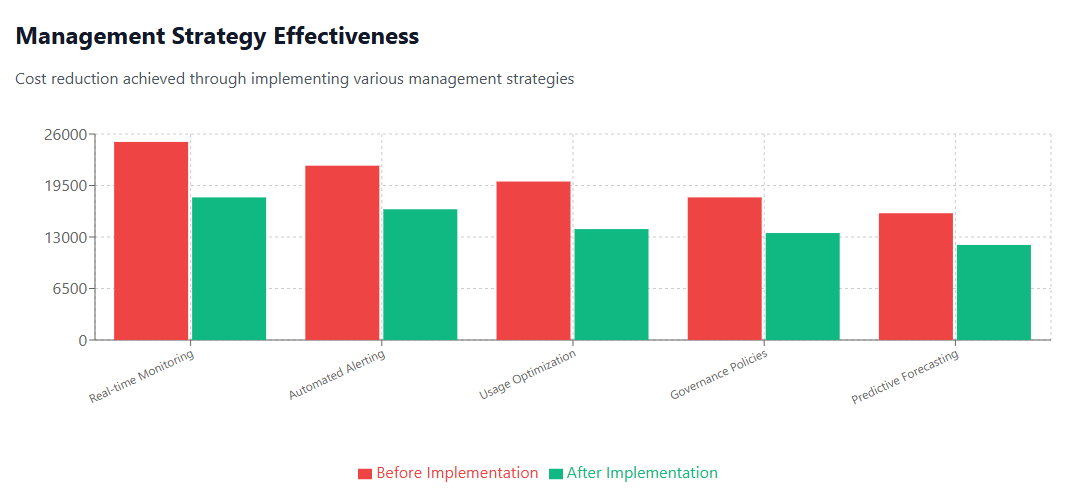
Building Predictive Forecasting Models
Developing sophisticated forecasting models is essential for managing the financial volatility associated with usage-based pricing. These models should incorporate multiple data sources, including historical usage patterns, business growth projections, and seasonal variations.
Effective forecasting models use machine learning algorithms to identify patterns and trends that might not be apparent through traditional analysis methods. They should provide multiple scenarios (best case, worst case, and most likely) to help organizations plan for various outcomes.
Organizations should regularly validate and update their forecasting models based on actual results, continuously improving their accuracy and reliability. This iterative approach helps organizations build confidence in their projections and make better financial decisions.
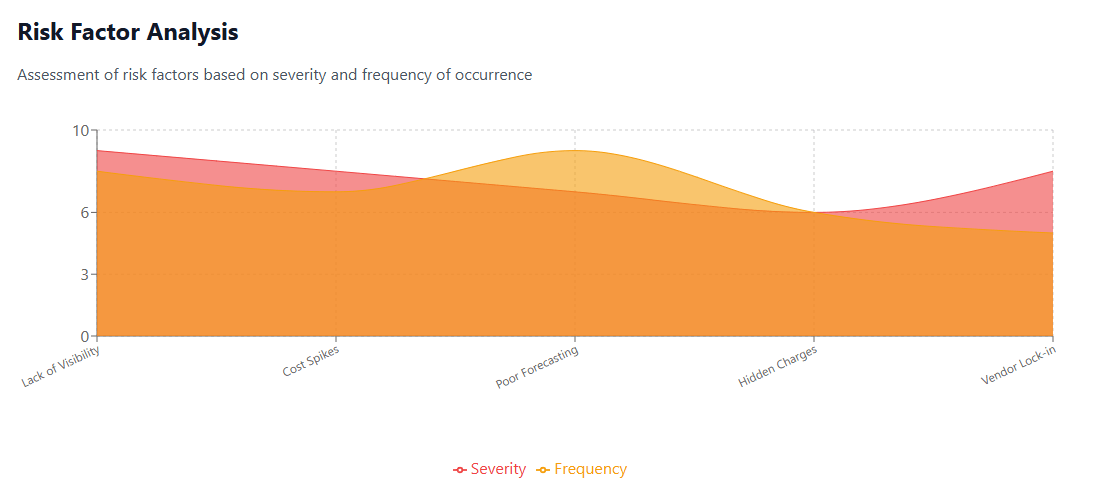
Technology Solutions for Usage-Based Pricing Management
Cloud Cost Management Platforms
Organizations managing significant usage-based costs should consider investing in specialized cloud cost management platforms that provide comprehensive visibility and optimization capabilities. These platforms typically offer features such as multi-cloud cost tracking, rightsizing recommendations, and automated policy enforcement.
Leading cloud cost management solutions provide detailed analytics that help organizations understand their consumption patterns and identify optimization opportunities. They offer customizable dashboards, automated reporting, and integration capabilities with existing financial systems.
For organizations seeking comprehensive cloud cost optimization, these platforms provide the visibility and control necessary to manage usage-based pricing effectively while maintaining operational efficiency.
SaaS Management and Optimization Tools
Organizations using multiple SaaS applications with usage-based components need specialized tools that provide visibility across their entire software portfolio. These tools help identify redundant services, track license utilization, and optimize subscription levels based on actual usage patterns.
Modern SaaS management platforms offer features such as automated discovery of software installations, usage analytics, and renewal management capabilities. They help organizations implement centralized app management strategies that reduce costs while ensuring that teams have access to the tools they need.
These tools are particularly valuable for organizations implementing comprehensive SaaS cost management strategies that encompass both traditional subscription and usage-based pricing models.
Financial Operations (FinOps) Frameworks
The complexity of managing usage-based pricing has led to the emergence of FinOps frameworks that combine financial management principles with cloud and technology operations. These frameworks provide structured approaches to cost management that emphasize collaboration between technical and financial teams.
FinOps practices include regular cost reviews, optimization initiatives, and cultural changes that promote cost awareness throughout the organization. Organizations implementing FinOps methodologies report significant improvements in their ability to manage variable costs and optimize their technology spending.
These frameworks emphasize continuous improvement and collaborative decision-making, helping organizations build sustainable practices for managing usage-based pricing across their technology stack.
Best Practices for Stakeholder Communication
Creating Transparent Reporting
Effective management of usage-based pricing requires transparent reporting that helps all stakeholders understand cost drivers and trends. Reports should be tailored to different audiences, providing technical details for IT teams while focusing on business metrics for executive leadership.
Regular reporting should include variance analysis that compares actual costs to budgeted amounts, trend analysis that identifies patterns over time, and optimization recommendations that suggest actionable improvements. These reports should be distributed consistently and provide clear explanations of any significant changes or anomalies.
Organizations should also implement real-time dashboards that provide immediate visibility into current consumption and costs, enabling rapid response to unexpected changes or issues.
Establishing Regular Review Cycles
Organizations should establish regular review cycles that bring together technical and financial stakeholders to assess usage-based costs and identify optimization opportunities. These reviews should occur monthly or quarterly, depending on the organization’s size and complexity.
Review meetings should focus on understanding cost trends, evaluating the effectiveness of optimization initiatives, and identifying new opportunities for improvement. They should also address any challenges or issues that teams are experiencing with usage-based pricing models.
These regular reviews help maintain organizational focus on cost management and ensure that usage-based pricing remains aligned with business objectives and financial constraints.
Planning for the Future
Scenario Planning and Risk Management
Organizations should develop comprehensive scenario planning capabilities that help them prepare for various usage-based pricing outcomes. This includes modeling the financial impact of business growth, market changes, and operational disruptions on their usage-based costs.
Effective scenario planning includes stress testing current cost models against extreme usage scenarios, developing contingency plans for cost spikes, and identifying early warning indicators that suggest potential issues.
Risk management strategies should include diversification across multiple vendors, maintenance of reserve capacity for critical services, and development of alternative solutions that can be implemented if costs become prohibitive.
Building Organizational Capabilities
Long-term success with usage-based pricing requires building organizational capabilities that span technical, financial, and operational domains. Organizations should invest in training programs that help teams understand usage-based pricing models and their implications.
This includes developing internal expertise in cost optimization, financial modeling, and vendor management. Organizations should also establish communities of practice that share knowledge and best practices across different teams and departments.
Building these capabilities helps organizations become more sophisticated consumers of usage-based services, enabling them to negotiate better terms, optimize their consumption patterns, and avoid common pitfalls.
Conclusion
Usage-based pricing models offer significant opportunities for cost optimization and operational flexibility, but they also introduce complex challenges that require sophisticated management approaches. Organizations that successfully navigate these challenges implement comprehensive monitoring systems, establish clear governance frameworks, and build organizational capabilities that span technical and financial domains.
The key to success lies in treating usage-based pricing management as a strategic initiative that requires ongoing attention and investment. Organizations that take a proactive approach to managing these costs, implementing automated SaaS tracking and cost-effective app management strategies, are better positioned to realize the benefits of usage-based pricing while avoiding the common pitfalls that lead to budget overruns and operational disruptions.
As usage-based pricing models continue to evolve and become more prevalent, organizations that master these management approaches will gain significant competitive advantages through improved cost efficiency, better resource utilization, and more predictable financial performance. The investment in proper tools, processes, and capabilities pays dividends through reduced costs, improved operational efficiency, and better alignment between technology consumption and business value creation.
By understanding the pitfalls, implementing appropriate management strategies, and building organizational capabilities, companies can successfully leverage usage-based pricing models to drive innovation and growth while maintaining financial control and predictability.

